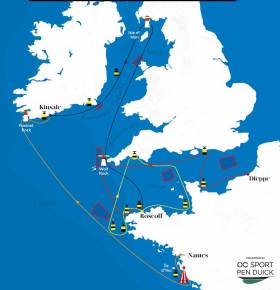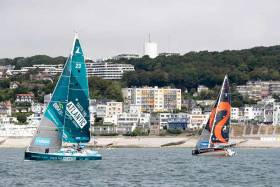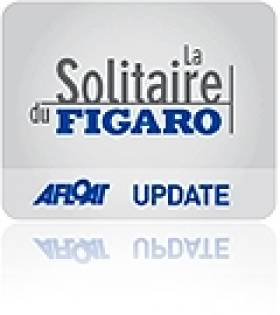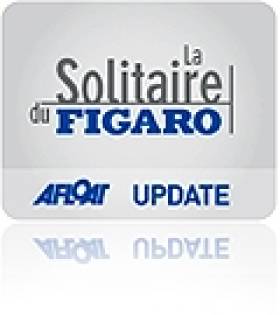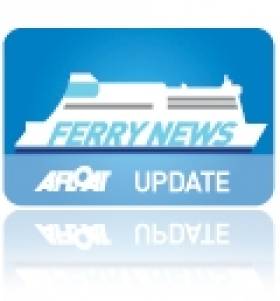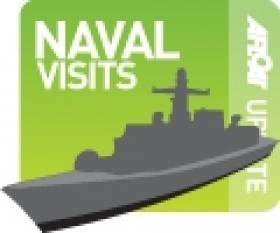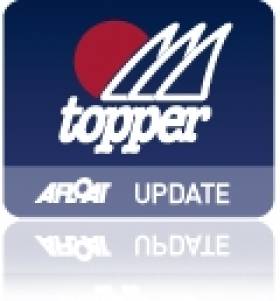Displaying items by tag: Figaro Race
Golden Jubilee Figaro in Kinsale & Round Isle of Man
The legendary Figaro URGO sailing show will be coming to Ireland and the Irish Sea big time for its Golden Jubilee season in 2019 writes W M Nixon, with a 20th visit to Kinsale being supported by a subsequent second stage from Kinsale to Roscoff using the Isle of Man as a mark of the course to provide a stage distance of 630 miles.
As previously reported by Afloat.ie, using the new foiling Figaro 3s (with Ireland’s Tom Dolan and Joan Mulloy already in possession of one apiece, for which they drew at the Paris Boat Show), the race will start from Nantes on 27th May, and will be a month-long series, as the course of Nantes to Kinsale, Kinsale to Roscoff via the Isle of Man, and Roscoff to Dieppe will not conclude until June 30th.
The fact that single-handed boats will be sailing in Irish waters is covered by the Figaro policy (particularly in evidence when they’re crossing the very busy English Channnel) of having a flotilla of substantial support vessels to shepherd them on their way. As to the visit to Kinsale, it will be quite like old times, as 40% of these major events have used Kinsale as a finish and start port.
Figaro Solo Tension Builds in Le Havre as Competitors Analyse Results of Prologue Practice Race
Sailing fans and supporters currently flocking into the French port of Le Havre for the start of the first of four stages of La Solitaire URGO Figaro 2018 on Sunday are looking to enjoy the shared and at times noisy excitement of one of sailing’s great events writes W M Nixon.
But the 36 lone skippers taking part are meanwhile seeking moments of peace to finalise their personal preparations - both of their boats and of themselves and their physical and mental condition - as this multi-faceted challenge is almost infinite in the demands it will make on them.
The renowned Marcus Hutchinson, who cut his sailing teeth in Howth, has since become a leading figure at the sharpest edge of the French sailing scene. He is deeply involved as a coach and adviser and has a veritable stable of Figaro talent to nurture, including rookie Joan Mulloy of County Mayo with her BIM-sponsored entry Taste the Atlantic.
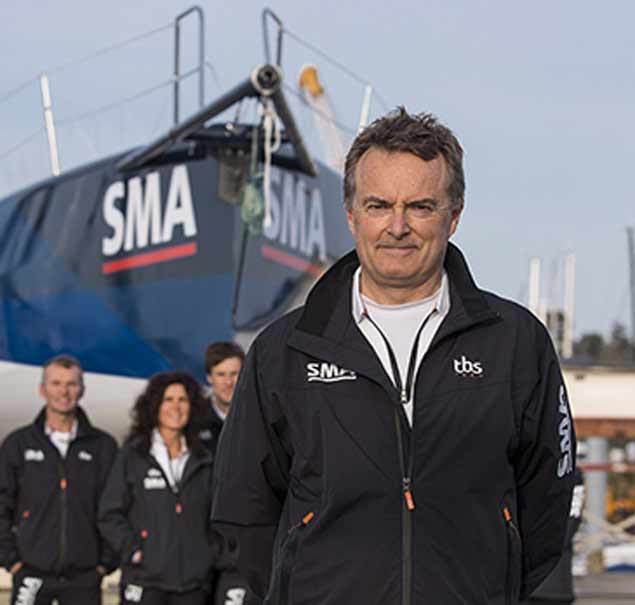 Marcus Hutchinson, the Vincent O’Brien of Figaro racing
Marcus Hutchinson, the Vincent O’Brien of Figaro racing
While we may point to Irish women athletes who have achieved top-level international success in times past, such as deservedly admired heroes like Sonia O’Sullivan and Annalise Murphy, it has to be remembered that their medals were achieved in women-only competitions. But La Solitaire URGO Figaro has been gender-blind since its inception in 1970, and the fact that Mulloy is the first Irish woman to take it on gives her campaign an added significance.
Over the years, we’ve had a few male participants, the most successful being Damian Foxall who actually won one of the legs – at this level, that’s quite an achievement in itself – and went on to build his exceptional global ocean racing career on it.
But for Joan Mulloy it’s still all in the future, though for the other Irish 2018 competitor, Tom Dolan of County Meath racing Smurfit Kappa, there’s a significant sailing CV is already in place, with worthy performances in the Mini Transat class, and a victory in the rookie division in this year’s Two-Handed Transatlantic Figaro Race.
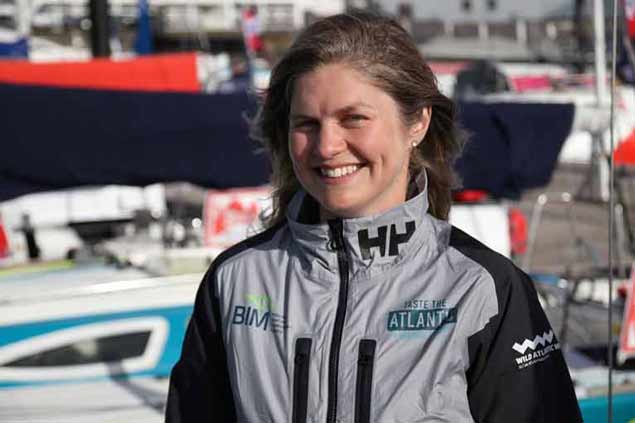 Joan Mulloy, Ireland’s first woman entrant in the Figaro
Joan Mulloy, Ireland’s first woman entrant in the Figaro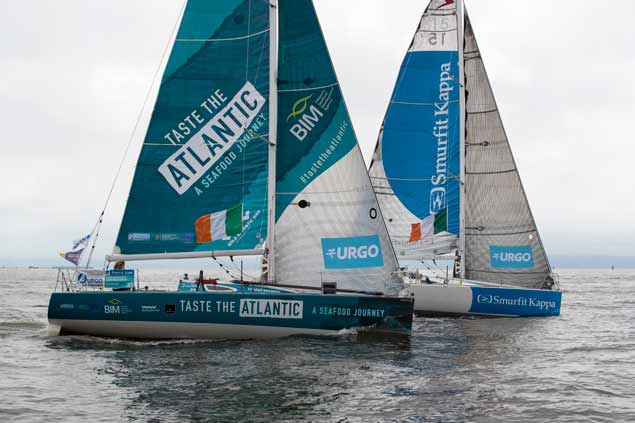 Two for Ireland – Joan Mulloy and Tom Dolan share a training session
Two for Ireland – Joan Mulloy and Tom Dolan share a training session
However, for both of them the short Prologue Race on Wednesday – it lasted for only an hour and a half – produced decidedly mixed results, for although both were up around 12th at one stage, by the finish Dolan was back in 22nd while Mulloy was 28th.
Sage observers including Marcus Hutchinson are firm in their assurance that the short Prologue gives only a very distorted guide to performance in a race which will provide 1695 miles of the most varied sailing imaginable. But then, he can afford to take the broad view in comfort, as one of his protégées, Alan Roberts from Scotland, was second in the Prologue after a scorching performance, while another – amateur sailor Hugh Brayshaw – was fourth.
As for the Prologue winner – reputedly a position which blights your subsequent performance in the big one itself – that was Martin le Pape, and he seemed remarkably sanguine about such early success.
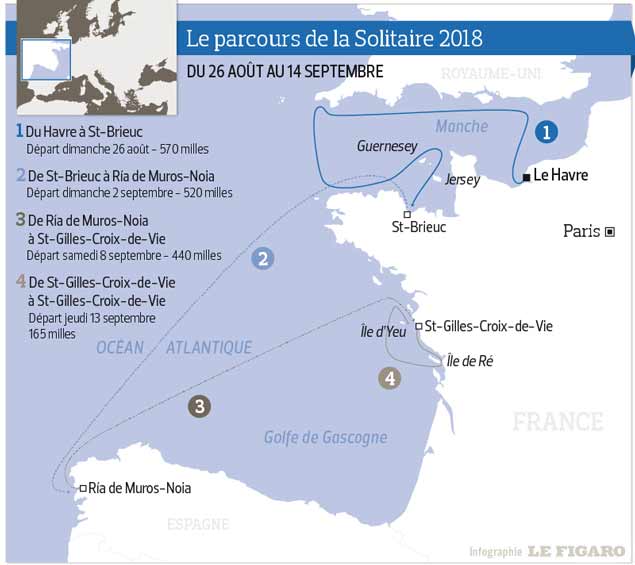 Even with a fully-crewed boat, this course would be a formidable challenge. Single-handed in such diverse waters and facing so many obstacles, it requires super-human endurance and concentration
Even with a fully-crewed boat, this course would be a formidable challenge. Single-handed in such diverse waters and facing so many obstacles, it requires super-human endurance and concentration
Solo Sailor David Kenefick Completes Second Figaro Race
#fullrish – Irish solo sailor David Kenefick shares some thoughts at the end of his second Figaro which I finished yesterday in Cherbourg.
The season
This was my second year and my biggest take out from the first year was to keep it as simple as possible. This is already a complicated project without making it harder for myself. Looking back at it now I am pretty satisfied that I wouldn't have changed anything in my preparation if I had to do it again.
I set myself the primary objective of wanting say to myself that I was satisfied with my season and my race when the project was done. Here I am the day after finishing my second Figaro season, four Fastnet races in a month singlehanded on a 32-foot boat SATISFIED. No question about it.
At the beginning of the year I realized I had a 50% chance of doing better than last year's result (28th). I know I sailed much better this year, I was confident with the boat, I had my moments of brilliance that lasted sometimes five minutes sometimes a whole afternoon, sometimes across a couple of days. I know it is about the result at the finish but I also knew inside myself that I sailed well most of the time.
I finished 23rd this year and I know exactly where I made mistakes and exactly how much they cost me. I also understand more and more why this race is so special and so tough. Jeremy Beyou won this year's race, his third victory in 13 attempts. He told me last night it took him nine years to get on the podium for the first time! My biggest lesson this year is quite how hard it is to do well, much harder than I thought this time last year and before I ever began I had no idea what this was about. But that is what makes it special, until you have done it you can't possibly imagine what its really about. Only people who have done the race will understand what I am talking about.
The whole experience was much more enjoyable than last year, of course because I had a vague idea of what I was getting into. Interestingly I slept a lot less this year during the race than last year but I know I am fresher now than this time last year.
Highlights and low points
Without a doubt the start at Deauville was my highlight. Nailing the pin end and rounding the top mark in third and holding all the way round the inshore course until out of sight of land was pretty special. Having my Dad Neil in the spectator fleet there too, watching made it extra special because the whole family has supported me so much in this project.
Probably the next high point was the exciting reach towards the Chausée de Sein in Leg 3. The weather wasn't very nice, drizzle, misty, all a bit tired but the boat going fast in a nice breeze with the big spinnaker set. Then we were hit by a big squall of over 35 knots. Luckily I had put my ballast snorkel down and so the boat filled up with water on the right side just in time and I just hung on driving it hard through the waves at ridiculous speeds on the edge of control whilst most boats around dropped their kites or broached out of control. I noticed Alan Gautier (a past Vendée Globe and Figaro winner) and Xavier Maquaire (2nd in Figaro last year) amongst these boats. I survived the squall, made the mark, gained some places and had a great buzz inside that I had controlled the situation well and made the most of it. Those are the kind of memories you will keep forever.
Then the low points, the scary moments. The first really downer was in leg three approach the BXA mark near Bordeaux. We had been at sea for three days and three nights at that stage, everyone was shattered. I was three miles from the mark which was a 90 degree turn to the North. Normally you are wide awake on the approach to the marks as there are plenty of things about to happen. Anyway, one of our fellow competitors Thierry Chabignet just sailed right past the mark and headed on towards the shore. No one could contact him and his boat sailed on for 30 minutes before we knew what was going on. The only reason that someone doesn't respond or sails past a mark is because they are not on the boat. We all had visions of Thierry floating past us in the water as we approached the mark. One of the escort boats finally got up close to his boat, he woke up and immeadiately put the boat back on course. It turns out he had slept through his alarm his boat had sailed the right side of the mark and just kept going.
On my own boat the scariest moment was on the last morning. We were approaching the West side of Guernsey to get out of the tide. Sailing upwind I had decided to get 15 minutes head down and I must have slept too long. I woke up with a start went up on deck and I swear I was doing six knots two or three boat lengths from a big rock sticking out of the water!!!!
Crash tack, ballast and jib on the wrong side but I saved it. I'm sure my keel was in the weed! If I had slept for 10 seconds more it would have ended differently. Of course on recovering from that I had to tack straight back into the rocks to get out of the tide again, but not sleeping again until last night when I finally got ashore.
The race is rich with stories like this. They are shared with all other competitors and everyone has their's to tell.
Future
It's dangerous to comment on the future the day after you finish this race. I will definitely do this race again. Not sure when but it is too special not to want to do it again. But for now I need to reflect on a lot of things in life. I need some time to recover and reflect on the last 18 months of my life, which frankly have been a whirlwind. I'm a bit tired of being alone and eating meals on my own. I need to reintegrate into society a bit for a while. Right now I have absolutely nothing planned after next week. This is probably the first time in my adult life that this has been the case, a weird feeling but great too.
I will repeat saying this until the day I die, you just can't describe how special this race is. It is brutally hard. Alan Gautier and Jeremie Beyou will tell you it is way tougher than the Vendée Globe, their words not mine. Racing against a clock makes it weird. Anyone out there needs a real mental and physical challenge in their lives needs to tackle this scene. The sense of community amongst the sailors at sea and ashore is also unique. Friends for life, respect for life.
Cork Solo Sailor to Make French Figaro Race Debut in 2013
#figaro – A 21–year–old Cork sailor has launched a bid to compete in one of the world's toughest offshore challenges. David Kenefick will debut in an international fleet that sails to Ireland next year in the 44th edition of the famous French La Solitaire du Figaro single-handed race.
The Crosshaven sailor who is currently training in La Grande Motte, Languedoc, France with the British Artemis team is fulfilling a long held ambition to compete in the race, one of the most competitive solo races in the world. The Cork Harbour helmsman will likely be the only Irish entry in the multi-stage offshore race.
"There are just over seven months to the start of the 2013 Solitaire du Figaro race and everyday in my training schedule counts. My programme is being managed by Figaro veteran Marcus Hutchinson who has organised my boat and technical programme and secured for me a place in the elite CEM training centre in La Grande Motte on the French Mediterranean coast. We will be here for the next five months developing my shorthanded sailing skills to such a level that I can confidently compete in the Solitaire du Figaro in 2013" Kenefick told Afloat.ie. The full campaign press release is available for download below as a pdf.
The unique stages of the race, the presence of great solo sailors regularly in the line up plus the fact it is also open to amateurs has made it one of the most appealing in offshore sailing. Sailors are required to sail long passages single-handedly catching only brief periods of sleep while underway.
French organisers have yet to nominate the 2013 Irish stop–over port for the 50 plus professional helmsmen who will race over 1600 miles.
The race has previously called to Kinsale, Dingle, Howth, Kenefick's own home port of Crosshaven and most recently Dun Laoghaire.
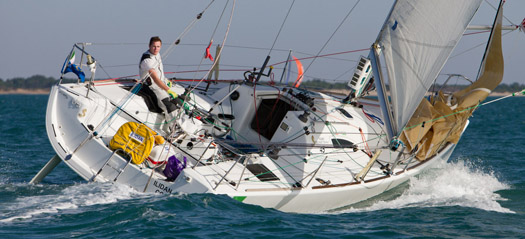
Irish rookie David Kenefick afloat in French waters at the start of his 2013 Figaro campaign. Photo: Brian Carlin
Noted America's Cup communications manager Hutchinson a former Figaro competitor in the 1998 and 2000 editions of the race and now based in Kinsale, is acting as a coach and mentor to the rookie Munster campaign, according to Kenefick's father Neil, the well known Cork Harbour yachtsman.
As well as Hutchinson previous Irish entrants in the event include Volvo race winner Damian Foxall and Paul O'Riain. In 2011, when the race called to Dun Laoghaire, the Dublin solo sailor Mick Liddy's chances were set-back through a lack of sponsorship.
The race is sailed in one design keelboats, Figaro Bénéteau II type yachts.
Kenefick's team is also seeking sponsorship but his 2013 bid is already on the water and competing in warm up events. The former Optimist,1720 and A35 ace has chartered a Figaro class yacht from the fleet of the famous French navigator Michel Desjoyeaux for a one year term. Desjoyeaux recently competed in Ireland in Dun Laoghaire at the helm of the winning MOD70 Foncia, when the tour visited Dublin Bay for the first time.
In spite of his young years Kenefick has over 30,000 sea miles, has completed some arduous voyages including two Fastnet races, a transatlantic and some high end TP52 sailing. Recently he completed a number of very strenuous Artemis British offshore duration sailing tests and showed plenty of promise.
Kenefick, the younger brother of George, Afloat's sailor of the year, is currently completing a six week training stint in France.
Kenedfick's introduction began at the age of three in the Royal Cork Yacht Club (RCYC) and progressed to sail for Ireland in the youth classes. He grew up across the river from the RCYC clubhouse so his only form of transport was a tender. Today he now have over 30,000 sea miles in different locations around the world and is also aiming for Master 200 certification and become one of the world's leading Super Yacht captains.
His recent sailing experience is below:
2011
2nd 1720 Europeans
NYYC Invitational Cup, sailing for his club the Royal Cork Yacht Club.
2010
Rolex Middle Sea race 2010,on Dublin yacht "Legally Brunette"
ISA All Ireland sailing Championships 2010' 3rd sailing with his father.
1st 1720 sports boat Europeans 2010.
Rolex Commodores Cup. He was part of the Hong Kong team were we finished 2nd.
2008
ACC Bank Cork Week 2008 - For Cork Week He skippered an IRC A 35.
Rolex Commodores Cup - Blondie IV king 40, part of Ireland' s finishing third overall.
BMW Round Ireland - 9th overall and 2nd in class 1. Kenefick's role on board was a watch leader in one of the windiest round Ireland's in the races history and the youngest sailor taking part in the race.
His campaign can be followed on twitter @davidkenefick
The full schedule for David Kenefick's programme is as follows:
CEM Training Centre, La Grande Motte (November-March)
Icom Cup, Marseille (6-12 March)
Solo Concarneau, Concarneau (4-9 May)
Transmanche, l'Aberwrach (16-20 May)
La Solitaire du Figaro, Bordeaux to Dieppe (2 – 31 June)
Cowes Week (3-9 August)
Rolex Fastnet Race (11-15 August)
Two-handed Tour of Brittany (31 August – 7 September)
Generali Med (22-30 September)
Calling Cherbourg: All Things Nauting
#FERRY SAILS – Ferry passengers perhaps on a mini-wine break cruise between Rosslare-Cherbourg may be taking a detour to the Cherbourg Nauting Boat Show which is been held this weekend, writes Jehan Ashmore.
Both Celtic Link Ferries and Irish Ferries operate on the continental route to the man-made Norman port originally constructed by Napoleon. The present day bustling town-centre of Cherbourg-Octeville to give its full name is close to the large 1500-plus berth marina at the Port Chantereyne which is hosting the show.
Those attending can buy and sell new and second-hand boats and where there will be exhibitors attending the three-day show which started yesterday. Activities include scuba-diving, dry surf, stand-up-paddle and model-boats on a dedicated pool.
In addition there is a guided-tour on a racing-boat commented by its skipper Eric D'Hooghe from the Figaro Race. Also making an appearance is the French rower Rémy Alnet who will be there to talk about his trans-Atlantic races.
Also on a related note is the La Cité de la Mer which is a museum situated in the former trans-Atlantic liner passenger terminal used during the so called golden era. The history of these liners is recalled in the museum and of course includes the RMS Titanic and the French Line's famous France which as the Norway made a once off anchorage call outside Dun Laoghaire Harbour.
In addition there are displays of submarines including the decomissioned French Navy nuclear-powered submarine Le Redoutable which is located in an adjoining dry-dock.
- Ferry news
- Cherbourg Nauting
- Napoleon Port of Cherbourg
- Port de Cherbourg
- Cite de la Mer
- CherbourgOcteville
- RosslareCherbourg
- Port Chantereyne marina
- Celtic Liink Ferries
- Irish Ferries
- WineBreak Mini Cruises
- Scubadiving
- DrySurfing
- standup paddle
- SUP
- ModelBoats
- New Boats
- SecondHand Boats
- TransAtlantic Liners
- Le Redoutable submarine
- French Navy
- RMS Titanic
- French Line's France
- Cruiseship Norway
- Dun Laoghaire Harbour
- Dun Laoghaire Harbour cruise liner calls
- Dun Laoghaire Harbour Norway anchorage call
- Cruiseships
- Cruiseliners
- Figaro Race
- Eric D'Hooghe
- French rower Remy Alnet
- Remy Alnet
- La Cité de la Mer
Naval School-Ships to take Class to Dublin
#NAVAL VISITS - The first foreign naval visitors to Dublin Port in 2012 will be the French Navy, as five of an eight-strong class of school-training ships from Brest are due to dock on Friday, writes Jehan Ashmore.
The octet belong to the Léopard class though the namesake leadship, Léopard (A 748) and Jaguar (A 750) will not be forming as part of the visiting flotilla.
Those that will be making the weekend port of call, berthing at Sir John Rogersons Quay will be Panthère (A 749) and Lynx (A 751) both commissioned in 1982 and the remaining quartet Guépard (A 752); Chacal (A 753); Tigre (A 754) and Lion (A 755) which entered service the following year. For a photo of the latter vessel and one of her sisters the Chacal click HERE.
Each of the 44 tonnes vessel's measure 17.5m long and have a beam of 6.40m and drawing a draft of 2.40m. To read more on the class characteristics click HERE.
The class follow in the wake of the last French Naval vessel to enter Dublin Bay, PSP Cormoran (P677). The OPV provided guard-ship duties when accompanying the Solitaire du Figaro race fleet during the stopover to Dun Laoghaire Harbour last August, as previously reported on Afloat.ie
National Yacht Club to Stage 2011 Topper Worlds
The 2011 Topper World Championships will be hosted by the National Yacht Club in Dun Laoghaire.
The club beating off stiff competition from around Europe to secure this major sailing event. It follows the successful 2010 Topper Worlds held at Lake Garda last August. The news was confirmed by Bill Brassington, President, International Topper Class Association.
Over 250 of the world's top youth sailors are expected to partake in the Irish event which will run from August 15th - 19th 2011 and promises some of the closest and most exciting youth sailing ever seen on Dublin Bay.
The Topper is one of the world's most popular youth boats with over 50,000 boats around the globe. It has grown greatly in popularity in recent years because it suits the learner sailor as well as those with ambitions of Olympic medals. Because it is exceptionally light and easy to transports the National Yacht Club are expecting 150 competitors from other countries to partake.
National Yacht Club Commodore Peter Ryan commented on the announcement: "We are delighted to be hosting the Topper World Championships next August. It will follow on from the Figaro Race stop over and reflects that fact that Dublin Bay can cater for top class events for both ends of the spectrum. The Topper is an extremely popular boat with young sailors and a great gateway to sailing so we will be putting all the club resources into making the event an outstanding success."
The Topper was designed by Ian Proctor whose other boats include the ever popular Wayfarer. It was originally constructed in GRP but this was changed quite early on to an injection moulding construction. After well over 20 years of continuous production it is the outstanding build quality, durability and innovative design features that have made the Topper a very popular boat. The Topper hull is injection moulded with incredible precision, reaching a level of uniformity quite outside the scope of any other production system, either hand built or mass produced in GRP or roto-moulded plastic. The material is polypropylene which has proved to combine strength and flexibility with lightness and virtually everlasting life.


























